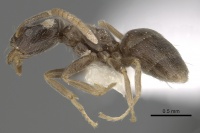Bothriomyrmex corsicus
| Bothriomyrmex corsicus | |
|---|---|

| |
| Scientific classification | |
| Kingdom: | Animalia |
| Phylum: | Arthropoda |
| Class: | Insecta |
| Order: | Hymenoptera |
| Family: | Formicidae |
| Subfamily: | Dolichoderinae |
| Genus: | Bothriomyrmex |
| Species: | B. corsicus |
| Binomial name | |
| Bothriomyrmex corsicus Santschi, 1923 | |
| Synonyms | |
| |
Bothriomyrmex corsicus is a thermophilous species, observed [within Greece] in pastures with shrubs and luminous deciduous forest. Nestsing under stones. It prefers lowland and upland areas located between 210-850 m. (Borowiec and Salata 2022)
Identification
Borowiec and Salata (2022), for Greece - Bothriomyrmex corsicus differs from the only Greek congener Bothriomyrmex communista in sparser and shorter appressed pubescence of gastral tergites which makes the surface of tergites well visible from under the hair. It has also broader clypeus with clypeal index 0.736-0.771.
Distribution
Latitudinal Distribution Pattern
Latitudinal Range: 49.366° to 37.252222°.
| North Temperate |
North Subtropical |
Tropical | South Subtropical |
South Temperate |
- Source: AntMaps
Distribution based on Regional Taxon Lists
Palaearctic Region: Austria, Bulgaria, Czechia, France (type locality), Greece, Hungary, Iberian Peninsula, Italy, Liechtenstein, Monaco, Montenegro, Romania, Russian Federation, Slovakia, Spain, Switzerland, Ukraine.
Distribution based on AntMaps
Distribution based on AntWeb specimens
Check data from AntWeb
Countries Occupied
| Number of countries occupied by this species based on AntWiki Regional Taxon Lists. In general, fewer countries occupied indicates a narrower range, while more countries indicates a more widespread species. |

|
Estimated Abundance
| Relative abundance based on number of AntMaps records per species (this species within the purple bar). Fewer records (to the left) indicates a less abundant/encountered species while more records (to the right) indicates more abundant/encountered species. |

|
Biology
Castes
Images from AntWeb
Worker
  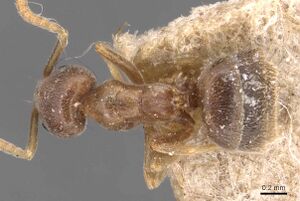 
| |
| Syntype of Bothriomyrmex corsicus gallicus. Worker. Specimen code casent0905119. Photographer Will Ericson, uploaded by California Academy of Sciences. | Owned by MSNG, Genoa, Italy. |
 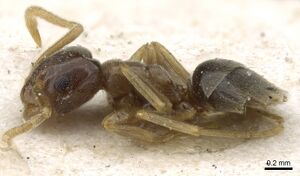  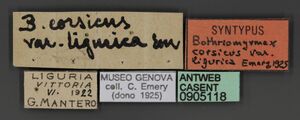
| |
| Syntype of Bothriomyrmex corsicus ligurica. Worker. Specimen code casent0905118. Photographer Z. Lieberman, uploaded by California Academy of Sciences. | Owned by MSNG, Genoa, Italy. |
   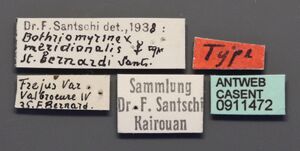
| |
| Syntype of Bothriomyrmex meridionalis bernardi. Worker. Specimen code casent0911472. Photographer Will Ericson, uploaded by California Academy of Sciences. | Owned by NHMB, Basel, Switzerland. |
   
| |
| Lectotype of Bothriomyrmex corsicus gallicus. Worker. Specimen code casent0911480. Photographer Will Ericson, uploaded by California Academy of Sciences. | Owned by NHMB, Basel, Switzerland. |
   
| |
| Syntype of Bothriomyrmex meridionalis gibbus. Worker. Specimen code casent0911481. Photographer Will Ericson, uploaded by California Academy of Sciences. | Owned by NHMB, Basel, Switzerland. |
    
| |
| Worker. Specimen code casent0281571. Photographer Estella Ortega, uploaded by California Academy of Sciences. | Owned by CAS, San Francisco, CA, USA. |
Queen
   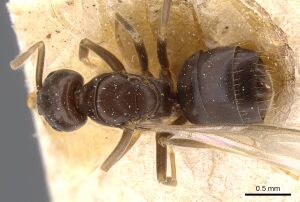 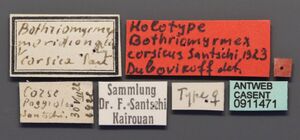
| |
| Holotype of Bothriomyrmex corsicus. Queen (alate/dealate). Specimen code casent0911471. Photographer Will Ericson, uploaded by California Academy of Sciences. | Owned by NHMB, Basel, Switzerland. |
    
| |
| Lectotype of Bothriomyrmex menozzii. Queen (alate/dealate). Specimen code casent0911484. Photographer Will Ericson, uploaded by California Academy of Sciences. | Owned by NHMB, Basel, Switzerland. |
    
| |
| Syntype of Bothriomyrmex menozzii. Queen (alate/dealate). Specimen code casent0905122. Photographer Will Ericson, uploaded by California Academy of Sciences. | Owned by MSNG, Genoa, Italy. |
Nomenclature
The following information is derived from Barry Bolton's Online Catalogue of the Ants of the World.
- corsicus. Bothriomyrmex meridionalis var. corsica Santschi, 1923a: 136 (q.) FRANCE (Corsica).
- Type-material: holotype queen.
- Type-locality: France: Corsica I., Poggiolo, 30.viii.1922 (F. Santschi).
- Type-depository: NHMB.
- Emery, 1925e: 12 (w.); Bernard, 1967: 266 (m.).
- Status as species: Emery, 1925e: 12; Bernard, 1967: 266 (redescription); Kutter, 1968a: 60; Kutter, 1968b: 205; Baroni Urbani, 1971c: 163; Collingwood, 1978: 87 (in key); Agosti & Collingwood, 1987b: 279 (in key); Shattuck, 1994: 32; Bolton, 1995b: 81; Petrov, 2006: 102 (in key); Casevitz-Weulersse & Galkowsky, 2009: 477; Seifert, 2012b: 100 (redescription); Borowiec, L. & Salata, 2012: 469; Kiran & Karaman, 2012: 4; Borowiec, L. & Salata, 2013: 351; Borowiec, L. 2014: 22; Lebas, et al. 2016: 108; Radchenko, 2016: 100; Steiner, et al. 2017: 7; Salata & Borowiec, 2018c: 43; Seifert, 2018: 248; Werner, et al. 2018: 6; Borowiec, L. & Salata, 2022: 35.
- Senior synonym of gallicus: Bernard, 1967: 266; Seifert, 2012b: 100; Radchenko, 2016: 100.
- Senior synonym of gibbus: Seifert, 2012b: 100; Radchenko, 2016: 100; Werner, et al. 2018: 6.
- Senior synonym of ligurica: Seifert, 2012b: 100; Radchenko, 2016: 100.
- Senior synonym of menozzii: Seifert, 2012b: 100; Radchenko, 2016: 100.
- Distribution: Austria, Bulgaria, Czech Republic, France (+ Corsica), Georgia, Greece, Italy, Kosovo, Liechtenstein, Romania, Slovakia, Slovenia, Switzerland, Turkey, Ukraine.
- [Note: distribution based on Borowiec, L. 2014: 22.]
- gallicus. Bothriomyrmex corsicus subsp. gallicus Emery, 1925e: 13, figs. A8, B5, C5 (w.q.m.) SWITZERLAND, FRANCE.
- Type-material: lectotype worker (by designation of Seifert, 2012b: 100), 3 paralectotype workers, 1 paralectotype queen.
- [Notes (i): original description cites syntype workers, queens, males (numbers not stated); (ii) Baroni Urbani, 1977e: 77, and Shattuck, 1994: 34, cite 1w, 1m syntypes NHMB.]
- Type-locality: lectotype Switzerland: Petit Salève, nr Geneva (A. Forel); paralectotypes: 2 workers with same data, 1 worker France: Dijon (Rouget), 1 queen France: Marseille (Abeille de Perrin).
- [Note: other original syntype localities: Switzerland: vic. Geneva (Tournier), vic. Geneva (Abeille de Perrin).]
- Type-depository: MSNG (lectotype); MSNG, NHMB (paralectotypes) (perhaps also MHNG).
- Subspecies of corsicus: Santschi, 1927b: 127; Novák & Sadil, 1941: 97 (in key); Bernard, 1950a: 20.
- Status as species: Kutter, 1971: 269; Kutter, 1977c: 176; Agosti & Collingwood, 1987b: 279 (in key); Shattuck, 1994: 34; Bolton, 1995b: 81; Casevitz-Weulersse & Galkowsky, 2009: 477.
- Junior synonym of corsicus: Bernard, 1967: 266; Seifert, 2012b: 100; Radchenko, 2016: 100.
- gibbus. Bothriomyrmex meridionalis subsp. gibbus Soudek, 1925a: 35 (w.q.m.) CZECH REPUBLIC (date of publication 15.iii.1925).
- Type-material: lectotype worker (by designation of Dubovikoff, 2002: 442), 3 paralectotype workers.
- [Notes (i): original description also includes queens and males (numbers not stated); (ii) Shattuck, 1994: 34, says that 5 workers NHMB (cited as syntypes by Baroni Urbani, 1977e: 78) are “possibly not type-material”.]
- Type-locality: lectotype Czech Republic: Moravia, Moravsky Kras, Suchy Zleb, 15.iv.1923 (S. Soudek), paralectotypes with same data.
- Type-depository: MMBC.
- [Also described as new by Soudek, 1925c: 216, figs. 1-10 (date of publication (31.xii).1925).]
- Subspecies of meridionalis: Soudek, 1931: 12.
- Status as species: Emery, 1925e: 14 (redescription); Stitz, 1939: 226; Novák & Sadil, 1941: 96 (in key); Kutter, 1963: 130; Baroni Urbani, 1971c: 165; Arnol’di & Dlussky, 1978: 548 (in key); Collingwood, 1978: 87 (in key); Bernard, 1967: 265 (redescription); Kutter, 1968a: 60; Kutter, 1968b: 205; Agosti & Collingwood, 1987a: 57; Agosti & Collingwood, 1987b: 279 (in key); Collingwood, 1993b: 195; Shattuck, 1994: 34; Bolton, 1995b: 81; Poldi, et al. 1995: 6; Dubovikoff, 2004: 442; Petrov, 2006: 102 (in key); Werner & Wiezik, 2007: 142; Casevitz-Weulersse & Galkowsky, 2009: 478; Lapeva-Gjonova, et al. 2010: 33; Karaman, M.G. 2011b: 62; Legakis, 2011: 23.
- Junior synonym of corsicus: Seifert, 2012b: 100; Radchenko, 2016: 100; Werner, et al. 2018: 6.
- ligurica. Bothriomyrmex corsicus var. ligurica Emery, 1925e: 13, fig. A7 (w.) ITALY.
- Type-material: 4 syntype workers.
- [Note: Baroni Urbani, 1977e: 77, and Shattuck, 1994: 32, cite 1w syntype NHMB.]
- Type-locality: Italy: Liguria Vittoria, vic. Gênes, vi.1922 (G. Mantero).
- Type-depositories: MSNG, NHMB.
- Menozzi, 1932a: 9 (q.m.l.); Wheeler, G.C. & Wheeler, J. 1951: 190 (l.).
- Subspecies of corsicus: Menozzi, 1932a: 9; Grandi, 1935: 102; Baroni Urbani, 1971c: 164; Shattuck, 1994: 32; Bolton, 1995b: 81.
- Status as species: Poldi, et al. 1995: 6.
- Junior synonym of corsicus: Seifert, 2012b: 100; Radchenko, 2016: 100.
- menozzii. Bothriomyrmex menozzii Emery, 1925e: 17, figs. B8, C8 (q.m.) ITALY.
- Type-material: syntype queens (number not stated, “several”), 1 syntype male.
- [Notes (i): Baroni Urbani, 1977e: 78, and Shattuck, 1994: 35, cite 1q syntype NHMB; (ii) Seifert, 2012b: 100, incorrectly cites a holotype queen; (iii) there is apparently no trace of the male.]
- Type-locality: Italy: Emilia, Marano (C. Menozzi).
- Type-depositories: MSNG, NHMB (perhaps also IEUB).
- Kutter, 1971: 270 (w.).
- Status as species: Baroni Urbani, 1971c: 166; Kutter, 1977c: 176; Agosti & Collingwood, 1987b: 279 (in key); Shattuck, 1994: 35; Bolton, 1995b: 81; Poldi, et al. 1995: 6; Markó & Csösz, 2002: 117; Petrov, 2006: 102 (in key); Casevitz-Weulersse & Galkowsky, 2009: 478; Lapeva-Gjonova, et al. 2010: 33; Csösz, et al. 2011: 58.
- Junior synonym of corsicus: Seifert, 2012b: 100; Radchenko, 2016: 100.
Unless otherwise noted the text for the remainder of this section is reported from the publication that includes the original description.
Description
Worker
Borowiec and Salata (2022) - Small: HL: 0.587-0.651 (mean 0.632); HW: 0.521-0.595 (mean 0.570); SL: 0.460-0.524 (mean 0.511); EL: 0.076-0.083 (mean 0.080); ML: 0.59-0.68; MW: 0.37- 0.41. Color. Whole body, including antennae and legs yellow. Head. Slightly elongate approximately 1.1 times as long as wide, on sides softly rounded, occipital corners rounded, occipital margin shallowly concave. Clypeus with diffused microreticulation but shiny, trapezoidal, its anterior margin convex, without median concavity, sides concave, convergent posterad, deeply excavate in front of antennal scrobes, posterior margin rounded. Clypeal surface with short and sparse appressed hairs, appears unhaired, anterior margin with a row of long setae and few short setae, the longest setae in the middle and in lateral corners, the longest anterior setae with length up to 0.159. Head with micropunctation, shiny, covered with very short and very sparse appressed pubescence not covering head surface, erected setae absent except single long, erected seta at anterolateral corners of frons. Scape short, approximately 0.9 times as long as width of head, thin, softly and regularly widened from base to apex, its surface microreticulate but shiny, with short and sparse appressed pubescence, erected setae absent. Funicular segments 1-3 slightly elongate, thin, first segment approximately twice as long as wide and 1.4 times as long as second segment, third segment distinctly shorter than second, the rest of funicular segments approximately as long as broad. Eyes small, almost circular, 0.13 length of head. Mandibles elongate, distinctly sculptured. Mesosoma. Moderately elongate, 1.6-1.7 times as long as wide, dorsally and laterally with diffused microreticulation but shiny, with short and sparse appressed pubescence. In lateral view pronotum softly convex, mesonotum straight, propodeum in line with mesonotum with oblique posterior face, mesonotal groove in form of deep suture. Mesosomal dorsum lacking erected setae. Waist and gaster. Petiolar scale in form of small, thin scale, with rounded apical margin. Gaster longer than mesosoma, tergites distinctly micropunctate and shiny interspaces, covered with moderately long and moderately dense appressed pubescence not covering the shiny background of tergites. First gastral tergite lacking erected setae, second tergite with a pair of long setae centrally and a single short seta laterally, third tergite with a row of four long erected setae in posterior half and a single long seta laterally, sternites without median keel. Legs. Moderately elongate, fore tibiae stout and broad, mid and hind tibiae slim, first segment of tarsi not longer than subsequent segments combined, surface of legs covered with moderately long and moderately dense appressed hairs, erected setae absent, inner margin of tibiae lacking row of thorns.
Type Material
Bothriomyrmex meridionalis gibbus
Dubovikov (2002) - Lectotype (designated here): W, “[Transcriptio] Moravia centr., Moravsky kras, Suchy Zleb, 15.IV.1923, St. Soudek leg.,” “Collectio J. Slavicek, Moravske museum, Brno,” "Bothriomyrmex meridianalis gibbus ssp. n. St. Soudek det.,” “syntypus,” “invent no. 1190 [Ent.] Mor. Museum, Brno,” “Lectotype Bothriomyrmex gibbus Soudek, 1924 Dubovikoff des.” (MMB, Moravian Museum, Brno, Czech Republic). Paralectotypes: 3 W, labels as in lectotype, but nos. 1187-1189 (MMB).
Bezděčková et al. (2017) - A lectotype and three paralectotypes are deposited in Moravian Museum, Brno, Czech Republic (all dry-mounted, glued on rectangular card labels):
- LECTOTYPE (worker): ‘Typus [p, dark red label] // Transcriptio [p, underlined] / Moravia centr. / Moravský kras 15. iv. / Suchý žleb 1923 / Št. Soudek leg. [hw] // Collectio / J. Slavíček / Moravské museum, Brno [p] // Transcriptio [p, underlined] / Bothriomyrmex [worker symbol] / meridionalis / gibbus ssp. n. / Št. Soudek det. [hw] // Syn- / typus [p, red label] // Invent. č. [p] / 1190 /Ent. [hw] / Mor. museum, Brno [p] // Lectotype / Bothriomyrmex / gibbus Soudek, / 1924 / Dubovikoff des. [hw, red label]’.
- PARALECTOTYPE (1 worker): ‘Macocha / 1923 Dr. Soudek [hw] // Bothr. merid. / gibbus. [hw] // Collectio / J. Slavíček / Moravské museum, Brno [p] // Transcriptio [p, underlined] / Moravia centr. / Moravský kras 15. iv. / Suchý žleb 1923 / Št. Soudek leg. [hw] // Transcriptio [p, underlined] / Bothriomyrmex / meridionalis [worker symbol] / gibbus ssp. n. / Št. Soudek det. [hw] // Syn- / typus [p, red label] // Invent. č. [p] / 1187 /Ent. [hw] / Mor. museum, Brno [p] // Paralectotype / Bothriomyrmex / gibbus Soudek, / 1924 / Dubovikoff des. [hw, red label]’.
- PARALECTOTYPE (1 worker): ‘Type [p, dark red label framed black] // Transcriptio [p, underlined] / Moravia centr. / Moravský kras / Suchý žleb 1923 / Št. Soudek leg. [hw] // Collectio / J. Slavíček / Moravské museum, Brno [p] // Transcriptio [p, underlined] / Bothriomyrmex [worker symbol] / meridionalis / gibbus ssp. n. / Št. Soudek det. [hw] // Syn- / typus [p, red label] // Invent. č. [p] / 1189 /Ent. [hw] / Mor. museum, Brno [p] // Paralectotype / Bothriomyrmex / gibbus Soudek / Dubovikoff des. [hw, red label]’.
- PARALECTOTYPE (1 worker): ‘Transcriptio [p, underlined] / Moravia centr. / Moravský kras / Suchý žleb 1923 / Št. Soudek leg. [hw] // Collectio / J. Slavíček / Moravské museum, Brno [p] // Transcriptio [p, underlined] / Bothriomyrmex [worker symbol] / meridionalis / gibbus ssp. n. / Št. Soudek det. [hw] // Syn- / typus [p, red label] // Invent. č. [p] / 1191 /Ent. [hw] / Mor. museum, Brno [p] // Paralectotype / Bothriomyrmex / gibbus Soudek / Dubovikoff des. [hw, red label]’.
Shattuck (1994) erroneously stated that the types of B. gibbus are housed in the Museum of Natural History, Basel.
Karyotype
- See additional details at the Ant Chromosome Database.
 Explore: Show all Karyotype data or Search these data. See also a list of all data tables or learn how data is managed.
Explore: Show all Karyotype data or Search these data. See also a list of all data tables or learn how data is managed.
- n = 11 (Italy) (Hauschteck-Jungen & Jungen, 1983) (as Bothriomyrmex gibbus).
References
- Bernard, F. 1967a [1968]. Faune de l'Europe et du Bassin Méditerranéen. 3. Les fourmis (Hymenoptera Formicidae) d'Europe occidentale et septentrionale. Paris: Masson, 411 pp. (page 266, male described)
- Bezděčková, K., Bezděčka, P., Macek, J., Malenovský, I. 2017. Catalogue of type specimens of ants (Hymenoptera: Formicidae) deposited in Czech museums. Acta Entomologica Musei Nationalis Pragae 57(1): 295-308 (doi:10.1515/aemnp-2017-0076).
- Borowiec, L. & Salata, S. 2013. Ants of Greece – additions and corrections (Hymenoptera Formicidae). Genus (Wroclaw) 24, 335-401.
- Borowiec, L. 2014. Catalogue of ants of Europe, the Mediterranean Basin and adjacent regions (Hymenoptera: Formicidae). Genus (Wroclaw) 25(1-2): 1-340.
- Borowiec, L., Salata, S. 2022. A monographic review of ants of Greece (Hymenoptera: Formicidae). Vol. 1. Introduction and review of all subfamilies except the subfamily Myrmicinae. Part 1: text. Natural History Monographs of the Upper Silesian Museum 1: 1-297.
- Csősz, S., Báthori, F., Gallé, L., Lőrinczi, G., Maák, I., Tartally, A., Kovács, É., Somogyi, A.Á., Markó, B. 2021. The myrmecofauna (Hymenoptera: Formicidae) of Hungary: Survey of ant species with an annotated synonymic inventory. Insects 16;12(1):78 (doi:10.3390/insects12010078).
- Dubovikoff, D.A. 2002. New species of the ant genus Bothriomyrmex Emery, 1869 (Hymenoptera, Formicidae) from the Caucasus. Entomol. Obozr. 81:918-922.
- Dubovikoff, D.A., Yusupov, Z.M. 2017. Family Formicidae - Ants. In Belokobylskij S. A. and A. S. Lelej: Annotated catalogue of the Hymenoptera of Russia. Proceedingss of the Zoological Institute of the Russian Academy of Sciences 6: 197-210.
- Emery, C. 1925c. Les espèces européennes et orientales du genre Bothriomyrmex. Bull. Soc. Vaudoise Sci. Nat. 56: 5-22 (page 12, raised to species)
- Emery, C. 1925c. Les espèces européennes et orientales du genre Bothriomyrmex. Bull. Soc. Vaudoise Sci. Nat. 56: 5-22 (page 12, worker described)
- Kiran, K., Karaman, C. 2020. Additions to the ant fauna of Turkey (Hymenoptera, Formicidae). Zoosystema 42(18), 285-329 (doi:10.5252/zoosystema2020v42a18).
- Kiran, K., Karaman, C., Lapeva-Gjonova, A., Aksoy, V. 2017. Two new species of the "ultimate" parasitic ant genus Teleutomyrmex KUTTER, 1950 (Hymenoptera: Formicidae) from the Western Palaearctic. Myrmecological News 25, 145-155.
- Lapeva-Gjonova, A., Antonova, V. 2022. An updated checklist of ants (Hymenoptera, Formicidae) of Bulgaria, after 130 years of research. Biodiversity Data Journal 10, e95599 (doi:10.3897/bdj.10.e95599).
- Santschi, F. 1923a. Notes sur les fourmis paléarctiques. 4ème note. Bol. R. Soc. Esp. Hist. Nat. 23: 133-137 (page 136, queen described)
- Schifani, E. (2022). The new checklist of the Italian fauna: Formicidae. Biogeographia – The Journal of Integrative Biogeography 37, ucl006 (doi:10.21426/b637155803).
- Seifert, B. 2012b. A review of the West Palaearctic species of the ant genus Bothriomyrmex Emery, 1869. Myrmecological News 17: 91-104.
References based on Global Ant Biodiversity Informatics
- AntArea. Accessed on February 5th 2014 at http://antarea.fr/fourmi/
- Antarea (Personal Communication - Rumsais Blatrix- 27 April 2018)
- Antarea (at www.antarea.fr on June 11th 2017)
- Baroni Urbani C. 1977. Katalog der Typen von Formicidae (Hymenoptera) der Sammlung des Naturhistorischen Museums Basel (2. Teil). Mitt. Entomol. Ges. Basel (n.s.) 27: 61-102.
- Bernard F. 1967. Faune de l'Europe et du Bassin Méditerranéen. 3. Les fourmis (Hymenoptera Formicidae) d'Europe occidentale et septentrionale. Paris: Masson, 411 pp.
- Bernard F. 1967. Recherches sur les fourmis des Monts-Dore. Annales de la Station biologique de Besse-en-Chandesse : 1-11.
- Bernard, F. "Notes sur les fourmis de France. II. Peuplement des montagnes méridionales." Annales de la Société Entomologique de France 115 (1950): 1-36.
- Bezdecka P. 1996. The ants of Slovakia (Hymenoptera: Formicidae). Entomofauna carpathica 8: 108-114.
- Bezdeckova K., P. Bexdecka, J. Macek, and I. Malenovsky. 2017. Catalogue of type specimens of ants (Hymenoptera: Formicidae) deposited in Czech museums. Acta Entomologica Musei Nationalis Pragae 57(1): 295-308.
- Blatrix R., C. Lebas, C. Galkowski, P. Wegnez, P. Pimenta, and D. Morichon. 2016. Vegetation cover and elevation drive diversity and composition of ant communities (Hymenoptera: Formicidae) in a Mediterranean ecosystem. – Myrmecological News 22: 119-127.
- Borowiec L. 2014. Catalogue of ants of Europe, the Mediterranean Basin and adjacent regions (Hymenoptera: Formicidae). Genus (Wroclaw) 25(1-2): 1-340.
- Borowiec L., and S. Salata. 2012. Ants of Greece - Checklist, comments and new faunistic data (Hymenoptera: Formicidae). Genus 23(4): 461-563.
- Borowiec L., and S. Salata. 2013. Ants of Greece additions and corrections (Hymenoptera: Formicidae). Genus (Wroclaw) 24(3-4): 335-401.
- Borowiec L., and S. Salata. 2017. Ants of the Peloponnese, Greece (Hymenoptera: Formicidae). Polish Journal of Entomology 86: 193-236.
- Bracko G., K. Kiran, C. Karaman, S. Salata, and L. Borowiec. 2016. Survey of the ants (Hymenoptera: Formicidae) of the Greek Thrace. Biodiversity Data Journal 4: e7945. doi: 10.3897/BDJ.4.e7945
- Buschinger, A., W. Ehrhardt, and K. Fischer. "Doronomyrmex pacis, Epimyrma stumperi und E. goesswaldi (Hym., Formicidae) neu für Frankreich." Insectes Sociaux 28 (1981): 67-70.
- Casevitz-Weulersse J. 1990. Etude Systematique de la Myrmecofaune Corse (Hymenoptera: Formicidae), deuxieme partie. Bull. Mus. Natn. Hist. Nat. Paris. 4eme serie 12, section A(2): 415-442.
- Casevitz-Weulersse J., and C. Galkowski. 2009. Liste actualisee des Fourmis de France (Hymenoptera, Formicidae). Bull. Soc. Entomol. Fr. 114: 475-510.
- Casevitz-Weulersse J., and M. Prost. 1991. Fourmis de la Côte-d'Or présentes dans les collections du Muséum d'Histoire Naturelle de Dijon. Bulletin Scientifique de Bourgogne 44: 53-72.
- Casevitz-Weulersse, J. "Contribution a la connaisance des fourmis de la Corse (Hymenoptera: Formicidae)." These de Doctorat Museum Nat (1989): 379pp.
- Collingwood, C. A. 1993. A Comparitive Study of the Ant Fauna of Five Greek Islands. Biologia Gallo-hellenica. 20,1:191-197
- Collingwood, C. A. "A comparative study of the ant fauna of five Greek islands." Biologia Gallo-Hellenica 20 (1993): 191-197.
- Csősz S., B. Markó, and L. Gallé. 2011. The myrmecofauna (Hymenoptera: Formicidae) of Hungary: an updated checklist. North-Western Journal of Zoology 7: 55-62.
- Czechowski W., A. Radchenko, W. Czechowska and K. Vepsäläinen. 2012. The ants of Poland with reference to the myrmecofauna of Europe. Fauna Poloniae 4. Warsaw: Natura Optima Dux Foundation, 1-496 pp
- Dubovikoff D. A., and Z. M. Yusupov. 2018. Family Formicidae - Ants. In Belokobylskij S. A. and A. S. Lelej: Annotated catalogue of the Hymenoptera of Russia. Proceedingss of the Zoological Institute of the Russian Academy of Sciences 6: 197-210.
- Emery, C. "Les espèces européennes et orientales du genre Bothriomyrmex." Bulletin de la Société Vaudoise des Sciences Naturelles 56 (1925): 5-22.
- Galkowski C. 2011. Une liste des fourmis (Hymenoptera, Formicidae) récoltées dans la région de Grasse, avec la mention dune nouvelle espèce de la faune de France. Bulletin de la Société linnéenne de Provence, 62 : 41-44.
- Garcia Garcia F., and A. D. Cuesta-Esgura. 2017. First catalogue of the ants of Burgos province, Spain (Hymenoptera: Formicidae). Boletín de la Sociedad Entomológica Aragonesa 60: 245–258.
- Grandi G. 1935. Contributi alla conoscenza degli Imenotteri Aculeati. XV. Boll. R. Ist. Entomol. Univ. Studi Bologna 8: 27-121.
- Hauschteck-Jungen E., and H. Jungen. 1983. Ant chromosomes. II. Karyotypes of western palearctic species. Insectes Soc. 30: 149-164.
- Karaman M. G. 2011. A catalogue of the ants (Hymenoptera, Formicidae) of Montenegro. Podgorica: Catalogues 3, Volume 2, Montenegrin Academy of Sciences and Arts, 140 pp.
- Kiran K. C. Karaman, A. Lapeva-Gjonova, and V. Aksoy. 2017. Two new species of the "ultimate" parasitic ant genus Teleutomyrmex KUTTER, 1950 (Hymenoptera: Formicidae) from the Western Palaearctic. Myrmecological News 25: 145-155.
- Kutter H. 1963. Miscellanea myrmecologica I. Mitteilungen der Schweizerischen Entomologischen Gesellschaft 35: 129-137.
- Lapeva-Gjonova, L., V. Antonova, A. G. Radchenko, and M. Atanasova. "Catalogue of the ants (Hymenoptera, Formicidae) of Bulgaria." ZooKeys 62 (2010): 1-124.
- Lebas C., C. Galkowski, P. Wegnez, X. Espadaler, and R. Blatrix. 2015. The exceptional diversity of ants on mount Coronat (Pyrénées-Orientales), and Temnothorax gredosi(Hymenoptera, Formicidae) new to France. R.A.R.E., T. XXIV (1): 24 33
- Markó B., and S. Csősz. 2002. Die europäischen Ameisenarten (Hymenoptera: Formicidae) des Hermannstädter (Sibiu, Rumänien) Naturkundemuseums I.: Unterfamilien Ponerinae, Myrmicinae und Dolichoderinae. Annales Historico-Naturales Musei Nationalis Hungarici 94: 109-121.
- Menozzi C. 1932. Contributo alla conoscenza della fauna mirmecologica d'Italia. Bollettino del Laboratorio di Entomologia del Reale Istituto Superiore Agrario di Bologna. 5: 8-12.
- Neumeyer R., and B. Seifert. 2005. Commented check list of free living ant (Hymenoptera: Formicidae) species of Switzerland. Bulletin de la Societe Entomologique Suisse 78: 1-17.
- Petrov I. Z. 2002. Contribution to the myrmecofauna (Formicidae, Hymenoptera) of the Banat Province (Serbia). Archives of Biological Sciences, Belgrade, 54(12): 57-64.
- Petrov I. Z. 2002. Contribution to the myrmecofauna (Formicidae,Hymenoptera) of Vojvodina (Serbia). Arch. Biol. Sci., Belgrade, 54, (34)27P28P.
- Petrov I. Z., and C. A. Collingwood. 1992. Survey of the myrmecofauna (Formicidae, Hymenoptera) of Yugoslavia. Archives of Biological Sciences (Belgrade) 44: 79-91.
- Plateaux L. 2000. Les fourmis de Lorraine. Bull. Soc. Ent. Lorr. 11-16.
- Rigato F., and R. Sciaky. 1989. Contributo alla conoscenza della mirmecofauna della Val Gesso (alpi Marittime) (Hymenoptera, Formicidae). Boll. Mus. Reg. Sci. Nat. Torino 7(2): 427-442.
- Rigato F., and R. Sciaky. 1991. The myrmecofauna of the Gesso Valley (Maritime Alps) (Hymenoptera Formicidae). Ethology Ecology and Evolution Special Issue 1: 87-89.
- Salata S., and L. Borowiec. 2018. Taxonomic and faunistic notes on Greek ants (Hymenoptera: Formicidae). Annals of the Upper Silesian Museum in Bytom Entomology 27: 1-51.
- Santschi, F. "Notes sur les fourmis paléarctiques. 4ème note." Boletín de la Real Sociedad española de Historia natural (Madrid) 23 (1923): 133-137.
- Schifani E., and A. Alicata. 2018. Exploring the myrmecofauna of Sicily: thirty-two new ant species recorded, including six new to Italy and many new aliens (Hymenoptera, Formicidae). Polish Journal of Entomology 87 (4): 323–348.
- Schulz A. 1991. Tetramorium semilaeve (Hym.: Formicidae, Myrmicinae) und Bothriomyrmex gibbus (Hym.: Formicidae, Dolichoderinae) neu für Österreich sowie über die Verbreitung von Leptothorax sordidulus (Hym.: Formicidae, Myrmicinae). Zeitschrift der Arbeitsgemeinschaft Österreichischer Entomologen 43: 120-122.
- Seifert B. 2012. A review of the West Palearctic species of the ant genus Bothriomyrmex Emery 1869 (Hymenoptera: Formicidae). Myrmecological News 17: 91-104.
- Sellier Y., C. Galkowski, C. Lebas, and P. Wegnez. 2016. Découverte de Temnothorax pardoi (Tinaut, 1987) dans la réserve naturelle nationale du Pinail (Hymenoptera, Formicidae). Revue de l’Association Roussillonnaise d’Entomologie 25(2): 106-113.
- Shattuck S. O. 1994. Taxonomic catalog of the ant subfamilies Aneuretinae and Dolichoderinae (Hymenoptera: Formicidae). University of California Publications in Entomology 112: i-xix, 1-241.
- Vassilev I. 1987. The ants (Formicidae, Hymenoptera) from the valley of the river Racene. Annuaire de l'Universite de Sofia Kliment Ohridski Faceulte de Biologie 78: 74-79.
